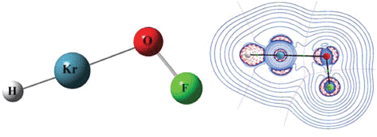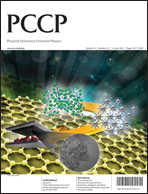Theoretical study of HKrOX (X = F, Cl, Br and I): structure, anharmonic vibrational spectroscopy, stability and bonding†
Abstract
The noble-gas molecules, HKrOX (with X = F, Cl, Br and I), have been investigated by ab initio calculation. Equilibrium geometry, harmonic and anharmonic vibrational frequencies, energies, partial charges are calculated. All HKrOX molecules studied here are bound equilibrium structures with Cs symmetry. The frequency calculation indicates that the H–Kr stretching mode is anharmonic and is very likely to be observed in the experiments. The two-body decomposition reaction is exothermic and lead to products of Kr as well as HOX, while the three-body decomposition reaction is also exothermic with respect to the neutral decomposition products (H + Kr + OX). Moreover, HKrOX is kinetically stable with respect to the decomposition reactions due to the enough high energy barriers, which indicates the possibility to identify these HKrOX compounds in noble-gas matrices. The bonding in HKrOX is studied by QTAIM analysis and the localized molecular orbital energy


 Please wait while we load your content...
Please wait while we load your content...